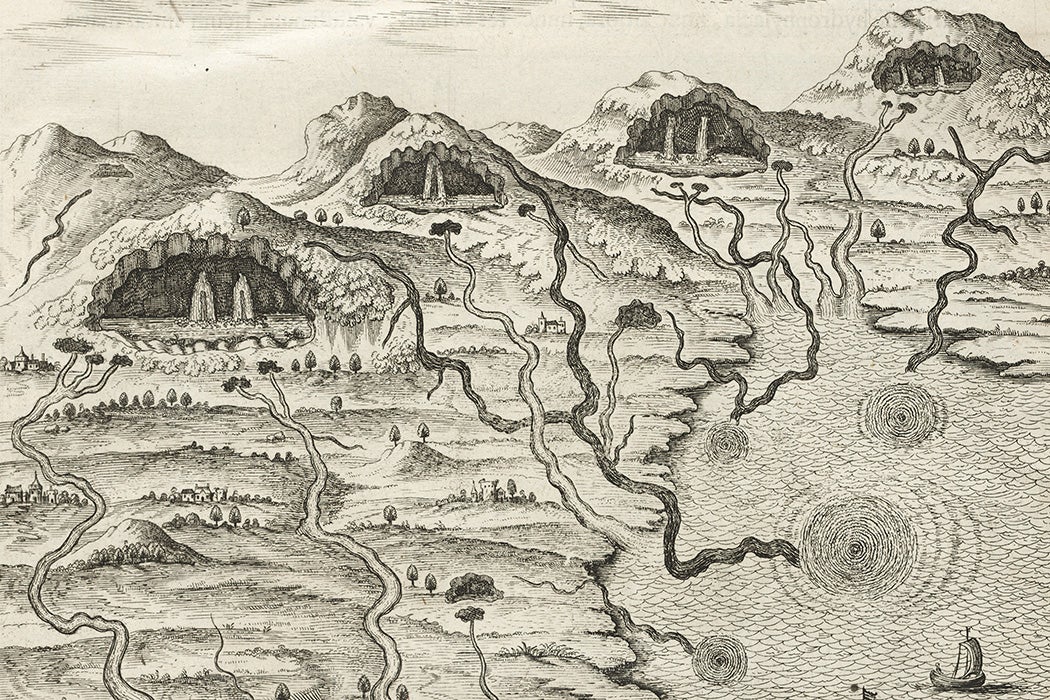Why the sky is blue is an ever-popular existential question on the nature of nature, but in the early modern era, the question of the water cycle was the one that “exercised the pens of many learned writers,” as the English polymath Robert Hooke put it. According to historian of science Francesco Luzzini, the lively debate over the water cycle offers glimpses of early versions of the “scientific method” and also encapsulates early modern debates over uniformitarianism, or the “uniformity of natural laws across time and space,” that we take for granted now.
Hooke, for his own part, proposed a theory that sounds remarkably like the mantra of evaporation, condensation, and precipitation now found in primary school classrooms—and, importantly for Hooke, was consistent with the Holy Scriptures.
“I conceive none more probable [theory] than that which seems to fetch its original from the History of the Creation mentioned in Holy Writ,” he wrote in a 1678 essay entitled Lectures de Potentia Restitutiva, Or of Spring Explaining the Power of Springing Bodies. “That is,” Hooke (the namesake of the physical law still used to understand simple mechanical springs) continued, “that there is a magazine of waters above receptacle of waters upon or beneath the surface of the Earth; and that the air is that firmament which separates between the upper and lower waters, and between these two is the circulation of Waters is performed.”
By Hooke’s account, sometimes “assisted by heat,” the water becomes “agitated with a greater degree of motion” and becomes “rarified and separated into minuter parts”—what we today might call evaporation. At other times, such as when there is a “deficiency of heat,” these minuter parts “lose their agitation, and many of them again coalesce […] and revert into water”—condensation. And, “being heavier than the encompassing air, [they] descend down again to the Earth” in various forms of precipitation.
But many of the early natural philosophers who took an experimental approach, such as Edmond Halley (of the elusive comet fame), were unconvinced that this cycle could account for all the water in the world. According to Luzzini, Halley’s meticulous measurements on evaporation, precipitation, and runoff “persuaded him that rain and snow events did not suffice to replenish fresh water supplies.” To account for this difference, natural philosophers in this camp subscribed to so-called alembics, where precipitation collected in low points of the earth would be filtered by the earth into freshwater rivers and streams. After falling from the sky, wrote Halley in 1691, “the water thereof gathers as in an alembick into the basons of the stone it finds,” which eventually overflows with water that “break[s] out by the sides of the hills, form[ing] single springs.”
Hooke and other detractors of the alembic theories often countered that there was no known way of turning saltwater into freshwater except by distillation—and certainly not by passing through the earth. At the end of the seventeenth century, a young Italian physician named Antonio Vallisneri chimed in with a great deal of “experiential” evidence. According to Luzzini, Vallisneri “seemed to embody the claim of the superiority of practice over speculation,” still something of a newfangled approach to the natural philosophers.
To definitively put alembics to rest, Valissneri devised an “experience” that would disprove that the earth turned saltwater into freshwater.
“They say that once thrown a well sealed pot into the sea, the water that soaks in through the pores of the pot becomes fresh, leaving the salt outside,” he wrote in 1698, like the water seeping through an alembic.
Valissneri simulated these circumstances by making a ball out of pottery clay and letting it soak in saltwater for eight days. “Having broken the ball,” he recounts, “I found that the salt water soaked in with no loss of salt,” definitely showing that “the sea water becomes fresh only by distillation, and not by filtration,” undermining the claim that alembics contributed to the freshwater supply.
Weekly Newsletter
Elsewhere in Italy, a colleague performed a similar experiment with a sealed pot of water—excitingly demonstrating that the principle remained true across space and time. But other thinkers remained skeptical that other parts of Valissneri’s observations, like of snowfall and snowmelt in the Northern Apennines, would remain true elsewhere in the world.
As Luzzini describes it, this response to Valissneri and his approach to refuting his forebears demonstrates how uniformitarianism “struggled to assert itself” in early modern science—a good reminder that “scientific progress is much more the outcome of humble, fragile, patient and collective enterprise than the result of the work of few brilliant, heroic geniuses.”
Support JSTOR Daily! Join our new membership program on Patreon today.







